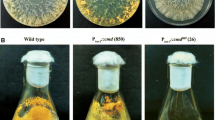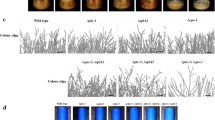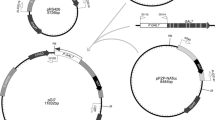Abstract
The ovc mutant of Neurospora crassa accumulates more carotenoids than the wild type in the light, is sensitive to high osmotic pressure and exhibits an altered aerial development. The three traits are complemented by a single gene, cut-1, but only the two latter are exhibited by a mutant of this gene carrying a premature stop mutation. Targeted cut-1 deletion results in a normal carotenoid content, confirming the involvement of at least a second gene in the carotenoid-overproducing phenotype of the ovc strain. Molecular analysis of ovc genomic DNA indicates the absence of a large DNA segment affecting the gene cut-1. A PCR walking approach allowed the identification of a deletion extending along 77,078 bp on linkage group IV. The break-points are located in ApA/TpT sequences, suggesting the involvement of UV-induced thymine dimers in the origin of the deletion. The ovc mutant lacks 21 predicted ORFs, including cut-1 as the only known genetic marker, and four ORFs from a 22-member transmethylase gene family. Ten ORFs have no similarity with any predicted gene from other species. Three of them are closely related by sequence and linkage, evoking ancestral gene duplications.





Similar content being viewed by others
References
Banks CW, Bennett SN, Krissinger WA (1997) Allelism of the mutants ovc and cut of Neurospora crassa. Fung Genet Newsl 44:10
Bok JW, Keller NP (2004) LaeA, a regulator of secondary metabolism in Aspergillus spp. Eukaryot Cell 3:527–535
Borkovich KA, Alex LA, Yarden O, Freitag M, Turner GE, Read ND, Seiler S, Bell-Pedersen D, Paietta J, Plesofsky N, Plamann M, Goodrich-Tanrikulu M, Schulte U, Mannhaupt G, Nargang FE, Radford A, Selitrennikoff C, Galagan JE, Dunlap JC, Loros JJ, Catcheside D, Inoue H, Aramayo R, Polymenis M, Selker EU, Sachs MS, Marzluf GA, Paulsen I, Davis R, Ebbole DJ, Zelter A, Kalkman ER, O’Rourke R, Bowring F, Yeadon J, Ishii C, Suzuki K, Sakai W, Pratt R (2004) Lessons from the genome sequence of Neurospora crassa: tracing the path from genomic blueprint to multicellular organism. Microbiol Mol Biol Rev 68:1–108
Colot HV, Park G, Turner GE, Ringelberg C, Crew CM, Litvinkova L, Weiss RL, Borkovich KA, Dunlap JC (2006) A high-throughput gene knockout procedure for Neurospora reveals functions for multiple transcription factors. Proc Natl Acad Sci USA 103:10352–10357
Davis RH, Perkins DD (2002) Timeline: Neurospora: a model of model microbes. Nat Rev Genet 3:397–403
de Serres FJ (1992) Development of a specific-locus assay in the ad-3 region of 2-component heterokaryons of Neurospora crassa: a review. Environ Mol Mutagen 20:225–245
de Serres FJ, Webber BB (1997) Quantitative and qualitative comparisons of spontaneous and radiation-induced specific-locus mutation in the ad-3 region of heterokaryon 12 of Neurospora crassa. Mutat Res 375:37–52
de Serres FJ, Malling HV, Brockman HE, Ong T-M (1997) Quantitative and qualitative comparison of spontaneous and chemical-induced specific-locus mutation in the ad-3 region of heterokaryon 12 of Neurospora crassa. Mutat Res 375:53–72
Deshpande AM, Newlon CS (1996) DNA replication fork pause sites dependent on transcription. Science 272:1030–1033
Galagan JE, Calvo SE, Borkovich KA, Selker EU, Read ND, Jaffe D, FitzHugh W, Ma LJ, Smirnov S, Purcell S, Rehman B, Elkins T, Engels R, Wang S, Nielsen CB, Butler J, Endrizzi M, Qui D, Ianakiev P, Bell-Pedersen D, Nelson MA, Werner-Washburne M, Selitrennikoff CP, Kinsey JA, Braun EL, Zelter A, Schulte U, Kothe GO, Jedd G, Mewes W, Staben C, Marcotte E, Greenberg D, Roy A, Foley K, Naylor J, Stange-Thomann N, Barrett R, Gnerre S, Kamal M, Kamvysselis M, Mauceli E, Bielke C, Rudd S, Frishman D, Krystofova S, Rasmussen C, Metzenberg RL, Perkins DD, Kroken S, Cogoni C, Macino G, Catcheside D, Li W, Pratt RJ, Osmani SA, DeSouza CP, Glass L, Orbach MJ, Berglund JA, Voelker R, Yarden O, Plamann M, Seiler S, Dunlap J, Radford A, Aramayo R, Natvig DO, Alex LA, Mannhaupt G, Ebbole DJ, Freitag M, Paulsen I, Sachs MS, Lander ES, Nusbaum C, Birren B (2003) The genome sequence of the filamentous fungus Neurospora crassa. Nature 422:859–868
Galagan JE, Selker EU (2004) RIP: the evolutionary cost of genome defense. Trends Genet 20:417–423
Harding RW, Philip DQ, Drozdowicz BZ, Williams NP (1984) A Neurospora crassa mutant which overaccumulates carotenoid pigments. Neurospora newsl 31:23–25
Horton P, Nakai K (1997) Better prediction of protein cellular localization sites with the k nearest neighbors classifier. Proc Int Conf Intell Syst Mol Biol 5:147–152
Kouzminova E, Selker EU (2001) dim-2 encodes a DNA methyltransferase responsible for all known cytosine methylation in Neurospora. Embo J 20:4309–4323
Lee SB, Taylor JW (1990) Isolation of DNA from fungal mycelia and single spores. In: Innis MA, Gelfand DH, Sninsky JJ, White TJ (eds) PCR protocols. A guide to methods and applications. Academic San Diego, pp 282–287
Liu Y, He Q, Cheng P (2003) Photoreception in Neurospora: a tale of two White Collar proteins. Cell Mol Life Sci 60:2131–2138
Margolin BS, Garrett-Engele PW, Stevens JN, Fritz DY, Garrett-Engele C, Metzenberg RL, Selker EU (1998) A methylated Neurospora 5S rRNA pseudogene contains a transposable element inactivated by repeat-induced point mutation. Genetics 149:1787–1797
Meganathan R (2001) Biosynthesis of menaquinone (vitamin K2) and ubiquinone (coenzyme Q): a perspective on enzymatic mechanisms. Vitam Horm 61:173–218
Michan S, Lledias F, Hansberg W (2003) Asexual development is increased in Neurospora crassa cat-3-null mutant strains. Eukaryot Cell 2:798–808
Michel B (2000) Replication fork arrest and DNA recombination. Trends Biochem Sci 25:173–178
Ninomiya Y, Suzuki K, Ishii C, Inoue H (2004) Highly efficient gene replacements in Neurospora strains deficient for nonhomologous end-joining. Proc Natl Acad Sci USA 101:12248–12253
Perkins DD (1997) Chromosome rearrangements in Neurospora and other filamentous fungi. Adv Genet 36:239–398
Pickford AS, Catalanotto C, Cogoni C, Macino G (2002) Quelling in Neurospora crassa. Adv Genet 46:277–303
Punt PJ, Oliver RP, Dingemanse MA, Pouwels PH, van den Hondel CA (1987) Transformation of Aspergillus based on the hygromycin B resistance marker from Escherichia coli. Gene 56:117–124
Radford A, Parish JH (1997) The genome and genes of Neurospora crassa. Fungal Genet Biol 21:258–266
Ravanat JL, Douki T, Cadet J (2001) Direct and indirect effects of UV radiation on DNA and its components. J Photochem Photobiol B 63:88–102
Royer JC, Yamashiro CT (1992) Generation of transformable spheroplasts from mycelia, macroconidia, microconidia and germinating ascospores of Neurospora crassa. Fungal Genet Newsl 39:76–79
Sambrook J, Russell DW (2001) Molecular cloning: a laboratory manual. Cold Spring Harbor Laboratory Press, New York
Sandmann G, Misawa N, Wiedemann M, Vittorioso P, Carattoli A, Morelli G, Macino G (1993) Functional identification of al-3 from Neurospora crassa as the gene for geranylgeranyl pyrophosphate synthase by complementation with crt genes, in vitro characterization of the gene product and mutant analysis. J Photochem Photobiol B 18:245–251
Saupe S, Turcq B, Begueret J (1995) A gene responsible for vegetative incompatibility in the fungus Podospora anserina encodes a protein with a GTP-binding motif and G beta homologous domain. Gene 162:135–139
Schmidhauser TJ, Lauter FR, Russo VE, Yanofsky C (1990) Cloning, sequence, and photoregulation of al-1, a carotenoid biosynthetic gene of Neurospora crassa. Mol Cell Biol 10:5064–5070
Schmidhauser TJ, Lauter FR, Schumacher M, Zhou W, Russo VE, Yanofsky C (1994) Characterization of al-2, the phytoene synthase gene of Neurospora crassa. Cloning, sequence analysis, and photoregulation. J Biol Chem 269:12060–12066
Schwerdtfeger C, Linden H (2003) VIVID is a flavoprotein and serves as a fungal blue light photoreceptor for photoadaptation. Embo J 22:4846–4855
Selker EU, Tountas NA, Cross SH, Margolin BS, Murphy JG, Bird AP, Freitag M (2003) The methylated component of the Neurospora crassa genome. Nature 422:893–897
Selker EU (2002) Repeat-induced gene silencing in fungi. Adv Genet 46:439–450
Shiu PK, Metzenberg RL (2002) Meiotic silencing by unpaired DNA: properties, regulation and suppression. Genetics 161:1483–1495
Smith ML, Yang CJ, Metzenberg RL, Glass NL (1996) Escape from het-6 incompatibility in Neurospora crassa partial diploids involves preferential deletion within the ectopic segment. Genetics 144:523–531
Vollmer SJ, Yanofsky C (1986) Efficient cloning of genes of Neurospora crassa. Proc Natl Acad Sci USA 83:4869–4873
Wang GY, Keasling JD (2002) Amplification of HMG-CoA reductase production enhances carotenoid accumulation in Neurospora crassa. Metab Eng 4:193–201
Xiang Q, Glass NL (2004) Chromosome rearrangements in isolates that escape from het-c heterokaryon incompatibility in Neurospora crassa. Curr Genet 44:329–338
Yoshida Y, Hasunuma K (2004) Reactive oxygen species affect photomorphogenesis in Neurospora crassa. J Biol Chem 279:6986–6993
Youssar L, Avalos J (2006) Light-dependent regulation of the gene cut-1 of Neurospora, involved in the osmotic stress response. Fung Genet Biol, in press
Youssar L, Schmidhauser TJ, Avalos J (2005) The Neurospora crassa gene responsible for the cut and ovc phenotypes encodes a protein of the haloacid dehalogenase family. Mol Microbiol 55:828–838
Yuan F, Zhang Y, Rajpal DK, Wu X, Guo D, Wang M, Taylor JS, Wang Z (2000) Specificity of DNA lesion bypass by the yeast DNA polymerase eta. J Biol Chem 275:8233–8239
Acknowledgments
We thank C. Vallejo and L. Pérez de Camino for technical assistance, L. Saelices for efforts to extend this work, and the Spanish Government (INIA, project PB96-1336, Ministerio de Ciencia y Tecnología, project BIO2003-01548) for financial support.
Author information
Authors and Affiliations
Corresponding author
Additional information
Communicated by K. Borkovich.
Electronic supplementary material
Rights and permissions
About this article
Cite this article
Youssar, L., Avalos, J. Genetic basis of the ovc phenotype of Neurospora: identification and analysis of a 77 kb deletion. Curr Genet 51, 19–30 (2007). https://doi.org/10.1007/s00294-006-0104-z
Received:
Revised:
Accepted:
Published:
Issue Date:
DOI: https://doi.org/10.1007/s00294-006-0104-z




